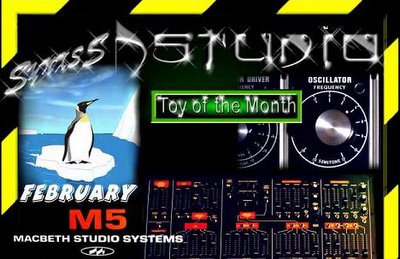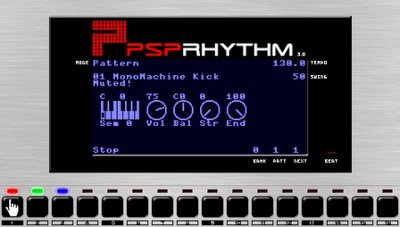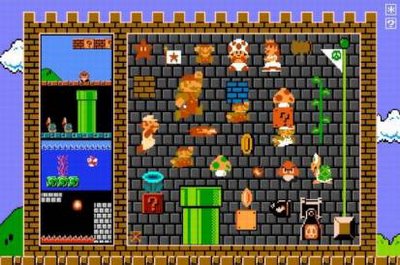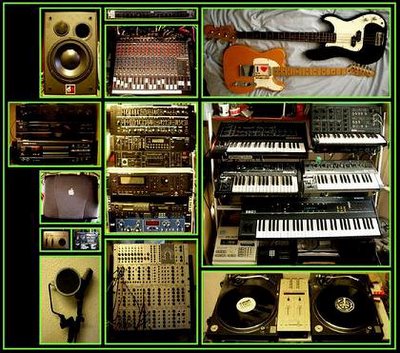
Tuesday, January 31, 2006
The Muse
Title link takes you to shots pulled from this auction. Notes from the auction below. Via David. Thanks David!

"14 trillion musical note combinations
It has been claimed that the Triadex Muse was the first digital device for making music. The original Muse was designed by Edward Fredkin, now at Carnegie-Mellon; and Marvin Minsky ( http://web.media.mit.edu/~minsky/ ), now at the M.I.T. Media Lab; in the late 1960's.
The Muse is a music composer machine or digital
synthesizer and melody composer, involving early
logic modules in a unique circuit that allows the
possibility of 14 trillion musical note combinations.
Manufacturer: Triadex Inc., Brookline, Massachusetts
Inventors: Edward Fredkin and Marvin Minsky
Original Price: $249
The Muse is an algorithmic music generator: it uses digital logic circuits to produce a sequence of notes based on the settings of various parameters. The four small sliders in the lower-left control Volume, Tempo, Pitch, and Fine Pitch. The switches to either side are used to start and stop the sequence, or to step through it note-by-note.
Of the eight larger sliders on the right, four control the musical intervals used (labeled A, B, C, and D), and four control the theme (labeled W, X, Y, and Z). A rest can be substituted for the lowest note by flipping a toggle switch. The exact logic behind the composition engine is rather technical, and not exactly intuitive. The tempo clock can be slaved to that of another Muse, allowing for multi-part compositions.
Their patent abstract of this electronic music composer reads as follows:
In the apparatus disclosed herein, a note generator is controlled by a long term, quasi-periodic function which is in turn generated by applying digital feedback in preselected combinations around a digital register. The register comprises means for holding a plurality of bits of digital information in a given order, e.g. a shift register or counter, the held information being changeable according to a predetermined pattern in response to input signals applied thereto. Digital feedback is provided by applying to the register at least one input signal which is obtained according to a preselectable or adjustable code from bits of information obtained from various points in the register itself. The apparatus thus, in effect, composes music as distinguished from merely synthesizing sound.
It is not known exactly how many Muses were made, but they are very rare, and were not available in stores."

"14 trillion musical note combinations
It has been claimed that the Triadex Muse was the first digital device for making music. The original Muse was designed by Edward Fredkin, now at Carnegie-Mellon; and Marvin Minsky ( http://web.media.mit.edu/~minsky/ ), now at the M.I.T. Media Lab; in the late 1960's.
The Muse is a music composer machine or digital
synthesizer and melody composer, involving early
logic modules in a unique circuit that allows the
possibility of 14 trillion musical note combinations.
Manufacturer: Triadex Inc., Brookline, Massachusetts
Inventors: Edward Fredkin and Marvin Minsky
Original Price: $249
The Muse is an algorithmic music generator: it uses digital logic circuits to produce a sequence of notes based on the settings of various parameters. The four small sliders in the lower-left control Volume, Tempo, Pitch, and Fine Pitch. The switches to either side are used to start and stop the sequence, or to step through it note-by-note.
Of the eight larger sliders on the right, four control the musical intervals used (labeled A, B, C, and D), and four control the theme (labeled W, X, Y, and Z). A rest can be substituted for the lowest note by flipping a toggle switch. The exact logic behind the composition engine is rather technical, and not exactly intuitive. The tempo clock can be slaved to that of another Muse, allowing for multi-part compositions.
Their patent abstract of this electronic music composer reads as follows:
In the apparatus disclosed herein, a note generator is controlled by a long term, quasi-periodic function which is in turn generated by applying digital feedback in preselected combinations around a digital register. The register comprises means for holding a plurality of bits of digital information in a given order, e.g. a shift register or counter, the held information being changeable according to a predetermined pattern in response to input signals applied thereto. Digital feedback is provided by applying to the register at least one input signal which is obtained according to a preselectable or adjustable code from bits of information obtained from various points in the register itself. The apparatus thus, in effect, composes music as distinguished from merely synthesizing sound.
It is not known exactly how many Muses were made, but they are very rare, and were not available in stores."
Monday, January 30, 2006
PSP OS 2.6 Hack is Out
Looks like PSP OS 2.6 has been hacked by Fanjita. What does this mean to us? PSPRhythm of course!
Update: Via PSPRhythm: "It is good to go! I heard some people tested it and 3.0 works. The eLoader Fanjita wrote for the 2.01, 2.5 and 2.6 firware require the game grand theft auto to run, so if you have that check out pspupdates.com or fanjita.org and get the loader!"

Update: Via PSPRhythm: "It is good to go! I heard some people tested it and 3.0 works. The eLoader Fanjita wrote for the 2.01, 2.5 and 2.6 firware require the game grand theft auto to run, so if you have that check out pspupdates.com or fanjita.org and get the loader!"

Super Mario Brothers Flash Based Synth

Nice. Create Digital Music has a post up on a Flash based Super Mario Brothers synth. Title link takes you there.
More NAMM 2006 Videos on Sonic State
Title link takes you to the full list of Sonic State videos. The following just added:
NAMM06: Moogerfooger Launch Bass Version Of MuRF (video)
NAMM06: Alesis Fusion New Voices (video)
NAMM06: Korg Radias Full Video Demo (video)
NAMM06: Moogerfooger Launch Bass Version Of MuRF (video)
NAMM06: Alesis Fusion New Voices (video)
NAMM06: Korg Radias Full Video Demo (video)
Musechnologist: Synthesizer Patel

Ok, first of all this is not me. Second his favorite color is green, so we do have that in common. Third, check out the towel rack! All synths should have this! Fourth, I wonder if that "Mini-Trelm 'Green-key' 800" functional, because if it is, I want one. Title link takes you there.
DMX Krew Studio
Update: Inteview Link on Gutterbreakz sent my way via Hans Visser. Thanks Hans!
Title link takes you to a new synth site by edmx. The design is intuitive in that you click on an image set to get to that gear page. Once on that page you can click on an instrument to get to that instrument's page. The instrument page has a load of info and samples. Cool design. Thanks edmx!

Title link takes you to a new synth site by edmx. The design is intuitive in that you click on an image set to get to that gear page. Once on that page you can click on an instrument to get to that instrument's page. The instrument page has a load of info and samples. Cool design. Thanks edmx!

PREVIOUS PAGE
NEXT PAGE
HOME













© Matrixsynth - All posts are presented here for informative, historical and educative purposes as applicable within fair use.
MATRIXSYNTH is supported by affiliate links that use cookies to track clickthroughs and sales. See the privacy policy for details.
MATRIXSYNTH - EVERYTHING SYNTH













© Matrixsynth - All posts are presented here for informative, historical and educative purposes as applicable within fair use.
MATRIXSYNTH is supported by affiliate links that use cookies to track clickthroughs and sales. See the privacy policy for details.
MATRIXSYNTH - EVERYTHING SYNTH




























